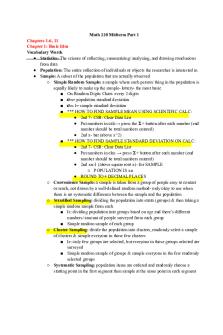Midterm 1 Guide PDF

| Title | Midterm 1 Guide |
|---|---|
| Course | Introduction To Developmental Social Personality And Clinical Psychology |
| Institution | The University of British Columbia |
| Pages | 3 |
| File Size | 136.3 KB |
| File Type | |
| Total Downloads | 51 |
| Total Views | 146 |
Summary
Midterm 1 Guide...
Description
PSYC 102 102:: MIDTERM EXA EXAM MR REVI EVI EVIEW EW Chapter 1: Psychology & Scientifi Scientificc Thinking
•
Learning Objectives: o Define Psychology o Discuss some of the complexities and difficulties in studying psychology o Identify the o o Explain why o o Identify principles of scientific thinking o Recognize and engage in critical thinking
•
Practice Questions: o Multiple Choice: Dr. Siela claimed that all humans had invisible souls that guided their behaviour. Which of the following principles of critical thinking is most applicable to his claim? A. Replicability B. Occam’s razor C. Ruling out rival hypotheses D. Falsifiability E. Correlation and causation o Short Answer: Jin is studying psychology when his roommate says, “Why bother taking psychology? Everyone knows psychology is the same as plain old common sense.” How should Jin explain the differences between psychology and common sense to his roommate?
Chapter 2: Resea Research rch Methods
•
Learning Objectives: o Describe 3 descriptive methods: naturalistic observation, case study, and questionnaires/survey; evaluate their advantages and disadvantages o Explain and contrast correlational and experimental research designs; discuss the limitations of both o Identify and distinguish positive versus negative correlations o Create and interpret scatterplots o Identify key components of experimental designs: independent variables, dependent variables, experimental groups, & control groups
o Generate an experimental research design o Define and explain measures of central tendency and variability (mean, median, mode, range, and standard deviation) o o Discuss ethical considerations and guidelines for psychologists conducting research o •
Practice Questions: o Multiple Choice: An administrator believes that the placement of motivational posters on the walls in classrooms of academic buildings will lead to increased grade-point averages at his school. To test his theory, in one of the academic buildings he randomly assigns certain classrooms to have the posters while others do not. None of the remaining four buildings on campus have any posters placed in their classrooms. What is the independent variable in this study? A. Classroom wall hangings B. Gender of the student C. The type of the academic institution D. Grade-point average E. The size of the buildings o Short Answer: Provide an example of two variables that are likely to be negatively correlated. Briefly explain what it means for variables to be negatively correlated.
Chapter 3: Intelligence & Tes Testing ting
•
Learning Objectives: o Contrast 4 main theories of intelligence (Spearman’s g, Cattell’s 2 types of intelligence, Sternberg’s triarchic theory, and Gardner’s multiple intelligences) o Calculate an intelligence quotient o Describe and contrast common tests of IQ o Consider difficulties in creating IQ tests o Discuss influences on intelligence/IQ test scores o Distinguish the unique characteristics of intellectual disability and mental giftedness (textbook) o Describe how creativity and emotional intelligence relate to intelligence (textbook)
•
Practice Questions: o Multiple Choice: Which of the following statements is true regarding the influence of gender on IQ test scores? A. On average, women tend to score higher on IQ tests than do men
B. Women’s IQ test scores tend to be more variable and more spread out than men’s test scores C. Men tend to score better on verbal tasks D. Men tend to score better on tasks related to spatial abilities E. All of the above are true o Short Answer: Which theory of intelligence do you believe is the most accurate? Explain why you support this theory, and provide 2 examples/pieces of evidence in support of that theory....
Similar Free PDFs

Midterm Study Guide 1
- 11 Pages

Midterm 1 Study Guide
- 15 Pages

Midterm 1 Guide
- 3 Pages

Midterm 1 Study Guide copy
- 10 Pages

BA Midterm 1 Study Guide
- 12 Pages

ASL 1 Midterm Study Guide
- 7 Pages

Philosophy Midterm 1 Study Guide
- 10 Pages

Study Guide for Midterm 1
- 2 Pages

Marketing Midterm 1 Study Guide
- 27 Pages

Midterm pt 1 study guide
- 20 Pages

A&P 1 Midterm Study Guide
- 6 Pages

Midterm study guide
- 6 Pages

Midterm Study Guide
- 18 Pages

Midterm Study Guide 1301
- 1 Pages
Popular Institutions
- Tinajero National High School - Annex
- Politeknik Caltex Riau
- Yokohama City University
- SGT University
- University of Al-Qadisiyah
- Divine Word College of Vigan
- Techniek College Rotterdam
- Universidade de Santiago
- Universiti Teknologi MARA Cawangan Johor Kampus Pasir Gudang
- Poltekkes Kemenkes Yogyakarta
- Baguio City National High School
- Colegio san marcos
- preparatoria uno
- Centro de Bachillerato Tecnológico Industrial y de Servicios No. 107
- Dalian Maritime University
- Quang Trung Secondary School
- Colegio Tecnológico en Informática
- Corporación Regional de Educación Superior
- Grupo CEDVA
- Dar Al Uloom University
- Centro de Estudios Preuniversitarios de la Universidad Nacional de Ingeniería
- 上智大学
- Aakash International School, Nuna Majara
- San Felipe Neri Catholic School
- Kang Chiao International School - New Taipei City
- Misamis Occidental National High School
- Institución Educativa Escuela Normal Juan Ladrilleros
- Kolehiyo ng Pantukan
- Batanes State College
- Instituto Continental
- Sekolah Menengah Kejuruan Kesehatan Kaltara (Tarakan)
- Colegio de La Inmaculada Concepcion - Cebu

